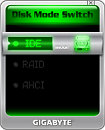- Joined
- Oct 9, 2007
- Messages
- 47,670 (7.43/day)
- Location
- Dublin, Ireland
| System Name | RBMK-1000 |
|---|---|
| Processor | AMD Ryzen 7 5700G |
| Motherboard | Gigabyte B550 AORUS Elite V2 |
| Cooling | DeepCool Gammax L240 V2 |
| Memory | 2x 16GB DDR4-3200 |
| Video Card(s) | Galax RTX 4070 Ti EX |
| Storage | Samsung 990 1TB |
| Display(s) | BenQ 1440p 60 Hz 27-inch |
| Case | Corsair Carbide 100R |
| Audio Device(s) | ASUS SupremeFX S1220A |
| Power Supply | Cooler Master MWE Gold 650W |
| Mouse | ASUS ROG Strix Impact |
| Keyboard | Gamdias Hermes E2 |
| Software | Windows 11 Pro |
Gigabyte released a new utility that allows you to change the mode of the chipset SATA controller between IDE, AHCI, and RAID (if available), from within Windows. While the switching isn't exactly on-the-fly (because changing SATA mode is effectively changing the SATA controller as Windows sees it, and hence can't happen on-the-fly), it certainly saves the trouble of going into BIOS setup and digging out that option. The utility works by writing the value of the selected mode to the CMOS, and prompting a system reboot for the change to take effect. Gigabyte's Disk Mode Switch utility works on Gigabyte motherboards based on Intel 6-series chipset (H61, H67, P67, and Z68). Now why you'd need a Windows-based utility to change a BIOS setting as infrequently changed as SATA controller mode is something we'll leave it to you to comment on.

DOWNLOAD: Gigabyte Disk Mode Switch
View at TechPowerUp Main Site

DOWNLOAD: Gigabyte Disk Mode Switch
View at TechPowerUp Main Site
Last edited:



 Especially with XP.
Especially with XP.
